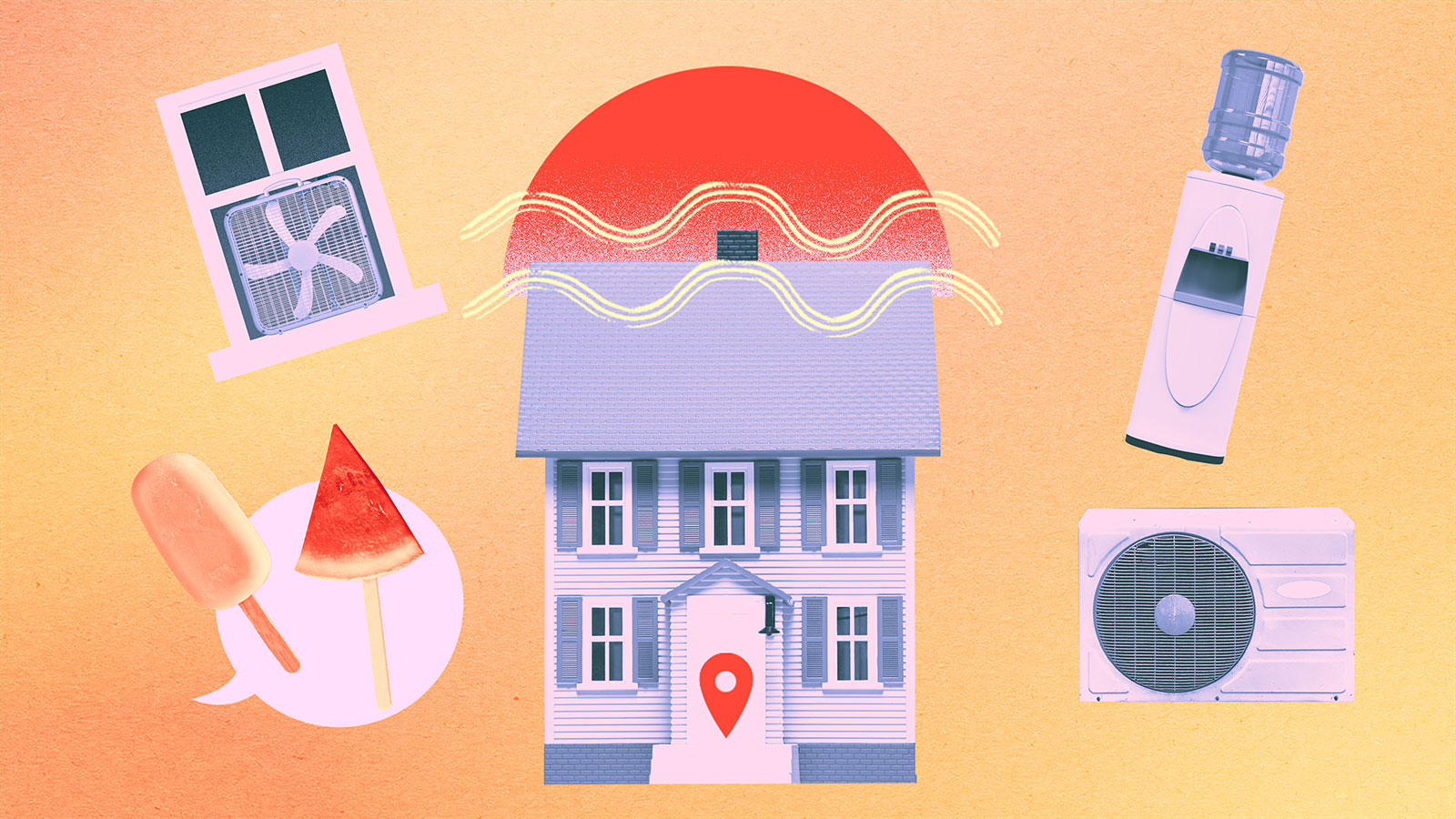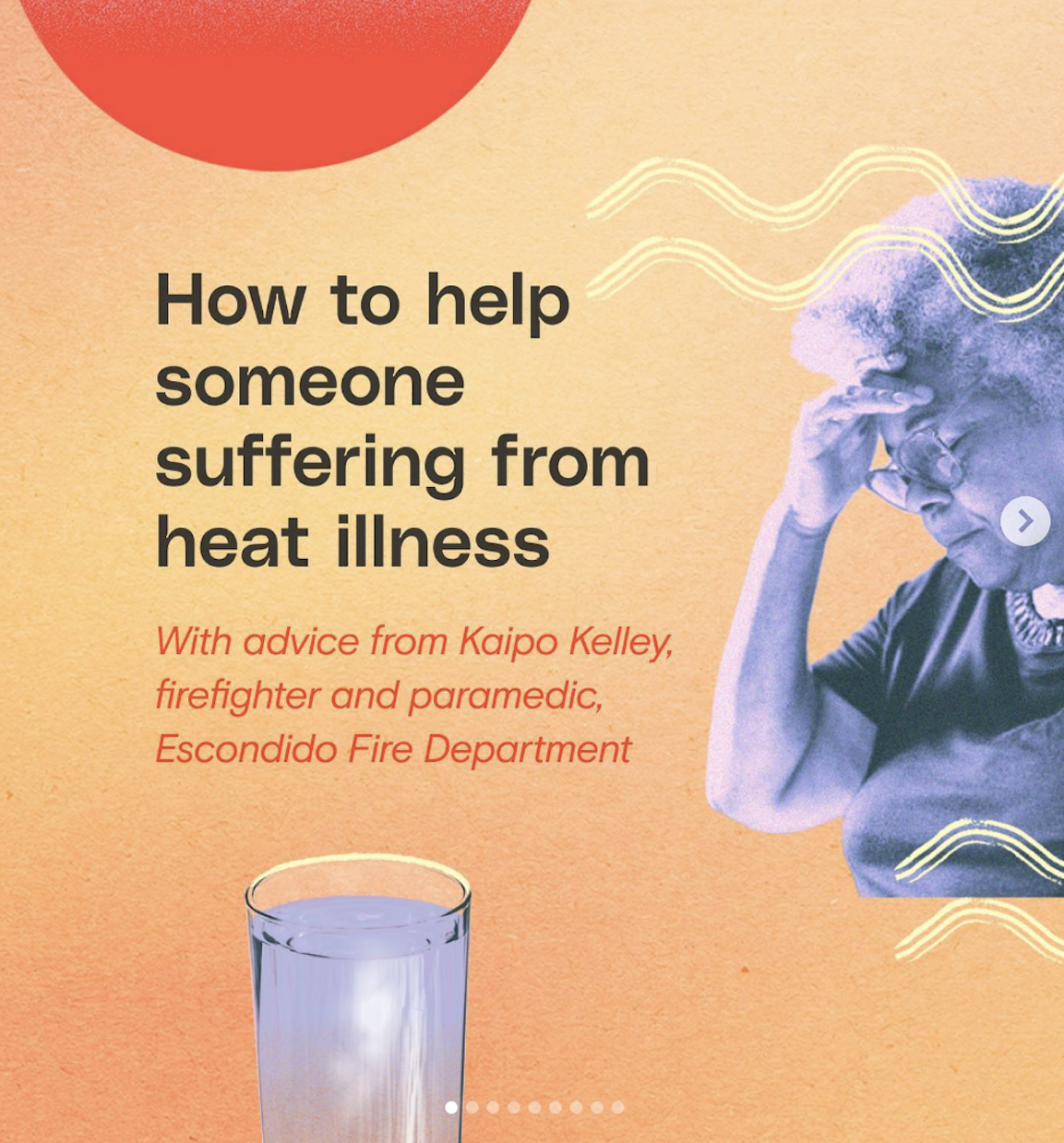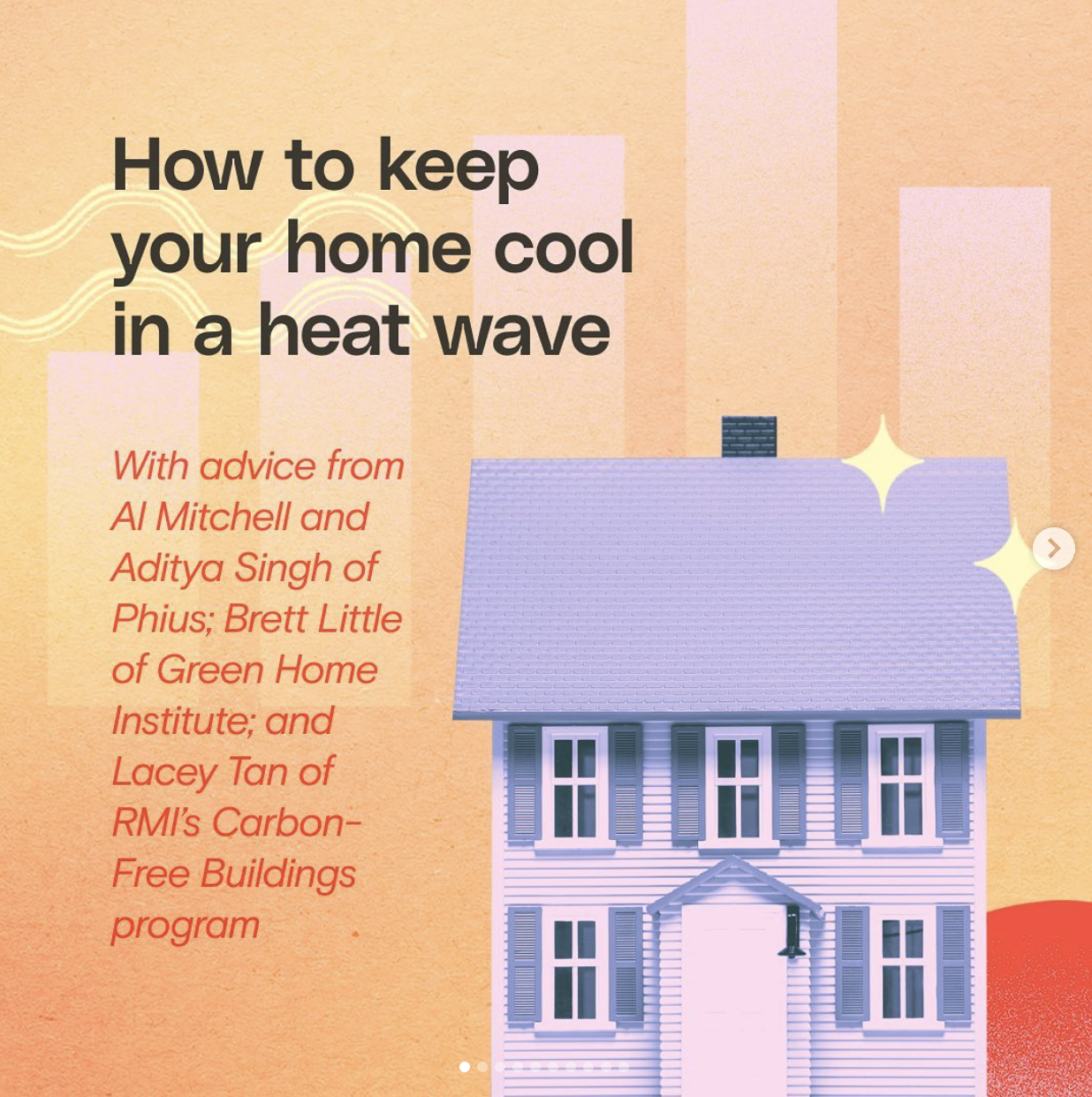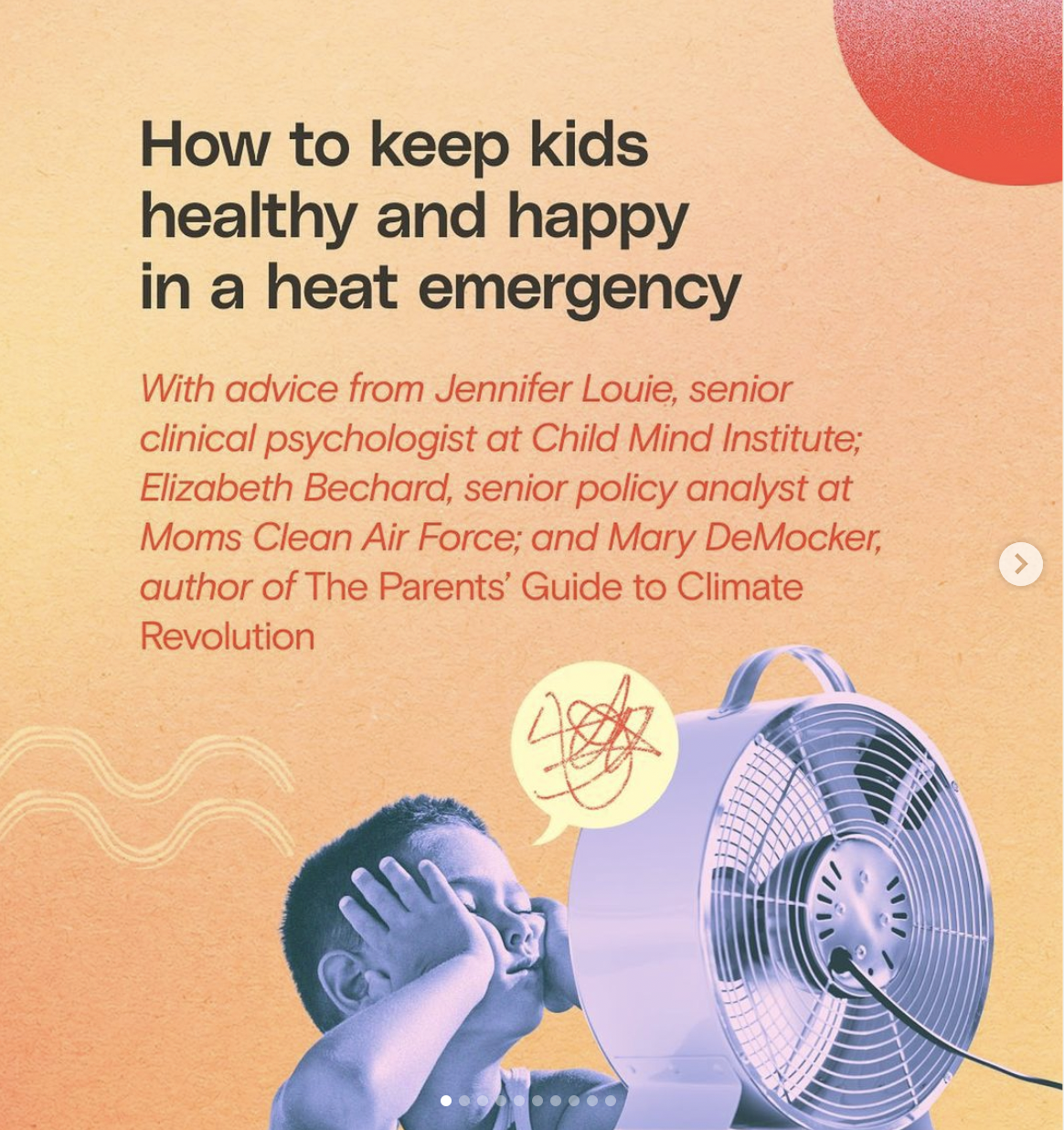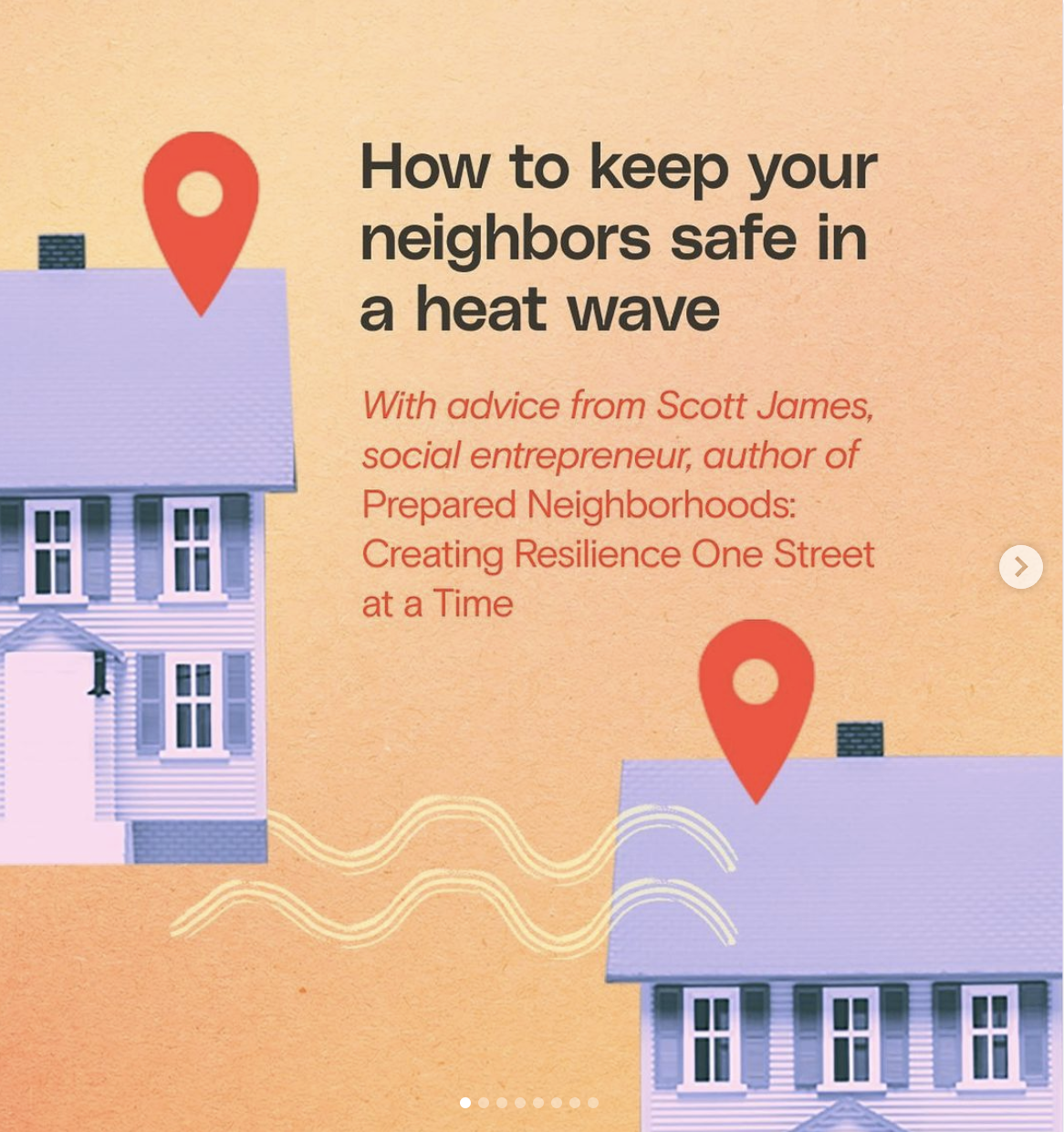This story is part of Record High, a Grist series examining extreme heat and its impact on how — and where — we live.
As the days get shorter and kids head back to school, it may seem like the worst of summer heat is over. But the thermometer tells a different story: Last week saw dangerous heat domes descend over both the Midwest and Pacific Northwest, and it’s late summer that often brings the most sizzling weeks of the season — last year, parts of the West experienced their hottest September on record. And climate scientists agree: Our summers are only going to get hotter from here.
To that end, Grist asked a dozen experts for their best tips, tricks, and hacks when it comes to keeping ourselves, our loved ones, and our surroundings safe in an extreme heat event.
To share these tips with your network, click a card below, or follow us on Intagram @Grist.
How to treat heat illness
With advice from Kaipo Kelley, firefighter and paramedic, Escondido Fire Department

You have to know the signs of heat illness to recognize when you or someone around you is suffering from it. Symptoms typically begin with heat cramps, which left untreated can worsen into heat exhaustion or a potentially fatal heat stroke, says Kaipo Kelley, a first responder in California. Here’s how to identify heat distress, and how to help.
Pay attention to cramping: Cramps typically occur while doing physical activity in heat. But what may feel like normal workout cramps are actually signs of serious dehydration. Look out for fatigue, sweating, and cramps in the legs, arms, and shoulders.
Move to a cool space: Get the person to shade or air conditioning, and have them hydrate with water and (if possible) electrolytes. Take off any unnecessary layers, such as jackets and backpacks, to help sweat evaporate, and massage the muscles to allow more blood flow to that area.
Recognize heat exhaustion: If a person ignores heat cramps, they could develop heat exhaustion as the body tries to preserve its vital organs by sending blood primarily to the core instead of the extremities. Signs include muscle aches or cramps; headache; excessive sweating and thirst; feeling lightheaded or dizzy; nausea or vomiting; and pale, cool, clammy skin, especially on the extremities.
Actively cool: In addition to removing heavy clothes, providing water, and moving to shade or A/C, help the person lay down and elevate their legs. Actively bring body temperature down by applying damp cloths, and spray them with water or a fan mister if available.
Watch out for heat stroke: Heat stroke occurs when the body’s temperature has reached dangerously high levels. A temperature at or above 103 degrees is life-threatening and can cause permanent injury to the brain. Signs of heat stroke include altered mental status; confusion, irritability, or unresponsiveness; severe fatigue; a fast pulse; nausea, vomiting, or diarrhea; lack of sweat (though sweating is possible too); and hot and dry skin.
Act fast: If you think someone is experiencing heat stroke, call 911, then take actions to quickly lower their temperature. In addition to the steps above, place ice packs on areas near large blood vessels, like the groin, armpits, neck, and core — or dunk them in cold or iced water. Only provide drinking water if they can maintain a gag reflex.
Go deeper: Red Cross offers a wide variety of first-aid training for individuals and organizations. NOLS’ Wilderness First Responder course teaches skills that are applicable to more than just the outdoors — you can also take their courses through your local REI store. Kelley also suggests looking up paramedic or EMT 101 courses at your local community college.
How to cool down a hot home
With advice from Al Mitchell and Aditya Singh of Phius; Brett Little of Green Home Institute; and Lacey Tan of RMI’s Carbon-Free Buildings program

Even if you don’t have air conditioning, there’s a lot you can do to alleviate the heat in your home before and during a heat wave. We asked sustainable-buildings experts for their best home hacks, retrofits, and gear that can help keep cool air in and hot air out.
Get an energy audit: Hire a professional to do a home assessment. Using specialized equipment, they can identify the places where hot air is seeping in and recommend energy-saving ways to prevent it — or you can do the audit yourself.
Seal your house: Close any openings around windows, doors, and attics to prevent hot air from entering. If you don’t know where or how to start, a weatherization contractor can help (the Department of Energy offers financial assistance and many utilities offer rebates). Interior storm inserts can help keep seal older windows, too.
Consider retrofits: Energy Star-certified reflective roofs and insulated interior shades with reflective outer layers help reject heat, better insulation and newer windows will help keep hot air out, and installing exterior overhangs above windows can block the sun.
Dehumidify ahead of time: Heat is most dangerous when it’s paired with humidity, which impedes the body’s ability to sweat. If you can’t afford a whole-home dehumidifier, get a standalone one and run it before a heatwave to get indoor humidity down to about 40 percent.
“Night flush” when it cools off: At nighttime when the outside air tends to be cooler than inside, place a box fan in the window of the warmest room to pull the hot air out. Then crack windows on the cooler sides of the house (probably the north side).
Go DIY: If you live in a dry climate, hang damp towels in front of windows to lower interior temperatures, or make your own air conditioner with a bucket of water, a fan, and some tubing — there are plenty of tutorials online.
Take advantage of tax credits: An energy-efficient home is often a cooler one, and the 2022 Inflation Reduction Act has introduced dozens of incentives in this regard. There are tax credits for energy audits, air sealing, insulation materials, energy-efficient doors and windows, and heat pumps, which use less electricity than air conditioners.
Go deeper: Rewiring America offers a great guide to which Inflation Reduction Act rebates and credits you qualify for and when they become available. Wildgrid can guide you through various insulation solutions and connect you with an expert.
How to keep kids healthy and happy in a heat wave
With advice from Jennifer Louie, senior clinical psychologist at Child Mind Institute; Elizabeth Bechard, senior policy analyst at Moms Clean Air Force; and Mary DeMocker, author of The Parents’ Guide to Climate Revolution
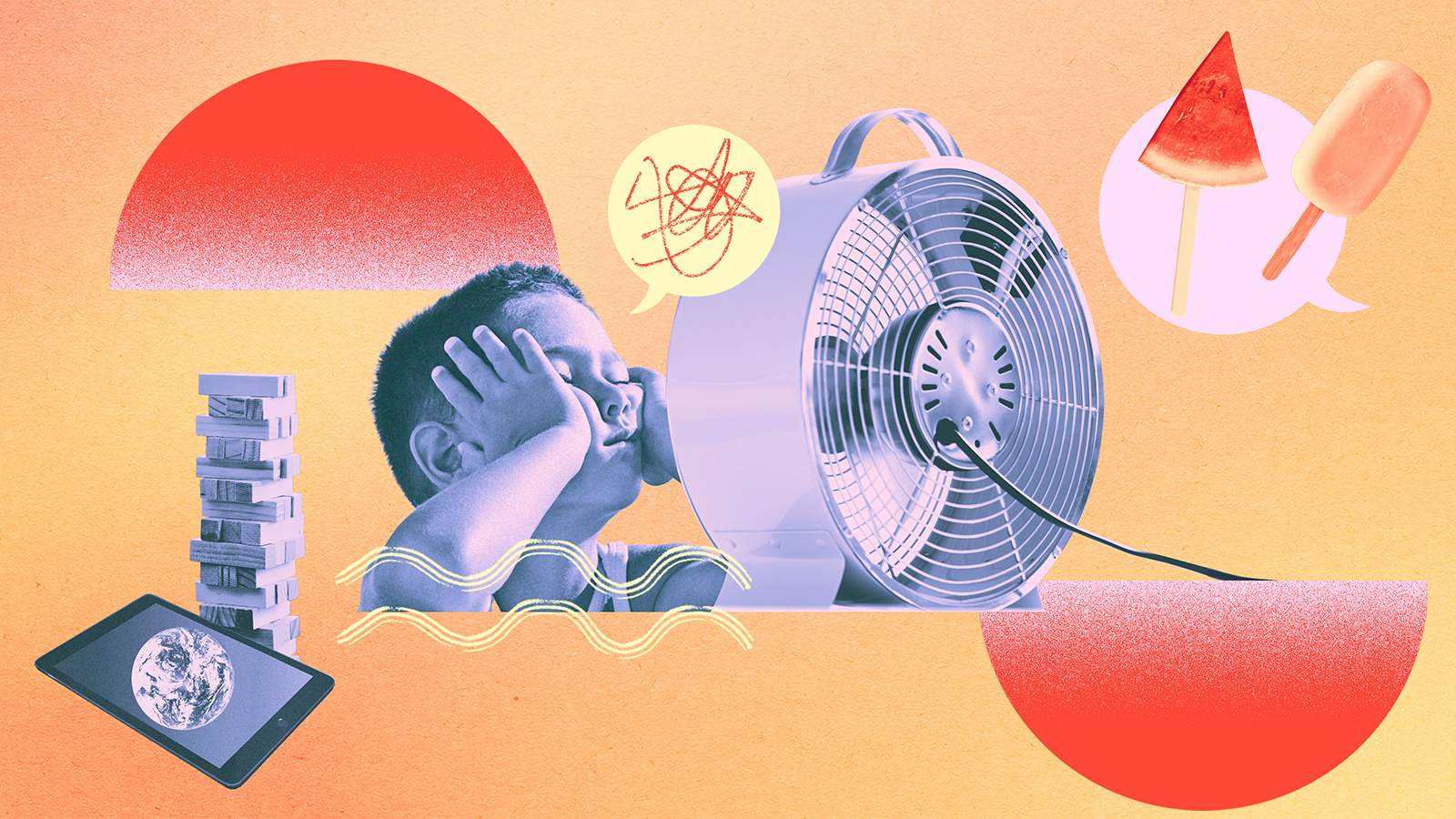
Children are especially vulnerable to excessive heat — smaller bodies can’t regulate temperature as efficiently as bigger, adult ones. It can also be more difficult for them to understand climate emergencies, leading to anxiety. We asked a psychologist, mental health policy analyst, and family advocate for ways to keep kids healthy and happy when temperatures are dangerous.
Be candid: Help kids understand heat waves by talking about the climate, what’s making it worse, and how families can fight back. For most kids 7 and up, be honest. For younger ones, children’s books can be especially helpful. Use the indoor time together to learn about the many science-based solutions within our collective reach.
Address their emotions: If kids express climate anxiety, be sure to listen, and acknowledge how they’re feeling. Tell them that you believe they can handle the fear, and that you’re there to help. Taking action to fight climate change, like composting or organizing a fundraiser, can also be empowering for kids of all ages.
Make a family plan: Ease feelings of uncertainty by working together on a course of action. Identify cool spaces to go, such as a family member’s house with A/C or a public library, and safe activities like visiting a pool, shady park, or movie theater. Review the signs of heat illness and discuss healthy things to eat and drink for cooling and hydration.
Keep kids hydrated: Make sure your kids are drinking cold water. If they’re resistant, try to make it tastier with some electrolyte powders, and add in cool, water-heavy foods, like watermelon, smoothies and fruit-juice popsicles.
Focus on indoor fun: Unplug! Stock your home with used puzzles, board games, art supplies, and even puppets for some imaginative play. Turn your living room into an art gallery: Challenge everyone to make a masterpiece and tack it to the wall. If your home is cool enough, get a little movement going by cranking the dance music, or trying indoor foam darts, hacky sacks, or juggling balls.
Loop in caretakers: Talk to your children’s teachers, childcare providers, and camp counselors to ensure everyone caring for your children knows what to do to prevent and treat heat-related illness. If your child takes medication, ask their doctor if it may make them more sensitive to extreme heat, and if so, make sure to tell any other caretakers.
Take care of yourself, too: Extreme heat can be profoundly stressful for parents, who need and deserve support as well. Tend to your own emotions about climate change by attending a peer climate support group or a Good Grief Network group, or even talking to a climate-aware therapist. Have as much compassion for yourself as possible.
Go deeper: Check out Elizabeth Bechard’s book Parenting in a Changing Climate and Mary DeMocker’s The Parent’s Guide to Climate Revolution: 100 Ways to Build a Fossil-Free Future, Raise Empowered Kids, and Still Get a Good Night’s Sleep. Moms Clean Air Force has put together a fact sheet on Climate Change and Mental Health, as well as a list of books and articles that can help parents talk to kids about climate change.
How to build a neighbor network
With advice from Scott James, social entrepreneur and author of Prepared Neighborhoods: Creating Resilience One Street at a Time

In a climate emergency like a heat wave, neighbors are our first line of defense — but only if we know who they are. Creating a neighbor network allows communities to gather contact information, pool resources, share skills, and identify who is most vulnerable in a crisis, says social entrepreneur Scott James, who wrote a book on the subject.
Host a meet-and-greet: Organize a neighborhood potluck for 20 or fewer people (keep your “pod” to a manageable size). Invite people whose homes are close together; in an emergency, that will make it easier to physically reach anyone who may need help. You don’t have to use the whole time for discussion, but leave at least 45 minutes for planning.
ID vulnerable neighbors: Make a contact list with everyone’s information and create a group text or social media group to be used in emergencies. Identify the elderly and those with medical conditions, no A/C, or other vulnerabilities, and designate who will check on them. Some of these neighbors may not have been able to attend your potluck, so go door-to-door if you need.
Create an asset map: Write down which neighbors might have useful skills in a heat emergency — like medical training or handyman abilities — as well as helpful equipment, like a portable power station or extra fans. Designate a “hub” where people can go if they need help and lack cell phone battery or signal.
Designate heat captains: Co-captains are best in case someone is out of town or needs help themselves. Create teams of people who are in charge of various tasks, whether that’s checking on elderly neighbors or setting up outdoor shade structures.
Draft an emergency plan: Compile all the info you’ve gleaned into a detailed outline or spreadsheet that can be printed and passed out or emailed to your pod. Keep a copy near your bed so that it’s easy to find if something happens in the middle of the night.
Prepare your resources: Keep a backup power bank charged as well as extra water, electrolytes, coolers, and ice on hand. Check that all fans are in working order to deploy to neighbors who need them. Store a tarp and rope to create shaded outdoor areas for people whose houses get too hot, as well as a bucket, water, and fan to make a “swamp cooler.”
Go deeper: This Map Your Neighborhood, or MYN, discussion guide from the Washington state Emergency Management Department can help anyone get started. The department also offers additional MYN planning documents. Joining or founding a Community Emergency Response Team, or CERT, is another great way to get your neighborhood ready for a climate event.
How to make a heat plan for your workplace
With advice from Jose Carnevali, Occupational Safety and Health Administration and Shiloh Rowe, safety director at Associated General Contractors, Austin

Working in sweltering conditions not only stifles productivity, it makes injuries more likely and poses a serious health risk. Many on-the-job heat emergencies are preventable — as long as your employer has a policy in place. Here’s what labor experts recommend when prepping a workplace to handle excessively hot temperatures.
Know the rules (and your rights): Employers are required by federal law to provide a workplace “free from recognized hazards,” including heat, that could cause employees harm. Some states, such as California and Minnesota, have also adopted their own heat standards. Familiarize yourself with employer obligations and employee rights on OSHA’s website, and remember that you can file a complaint with OSHA if your job doesn’t feel safe.
Get ahead of risk: Work as a group to identify existing and potential hazards and what could be done to mitigate them. Maybe there’s a room with a faulty A/C, a pipe that always gets too hot, or a broken water fountain — be proactive about addressing dangers.
Train the team: Employees should be informed on the signs of heat illness and how to treat it. OSHA developed a printable heat-related illness prevention guide for employers, which doubles as a training aid and is also available in Spanish. Better yet, offer a comprehensive first-aid course, and make sure someone is always on the clock who is trained in first aid.
Appoint a heat captain: Designate someone who will monitor coworkers for heat illness and who is authorized to stop work if conditions are too dangerous. Allow them to adjust work hours to cooler times of the day and make other accommodations, if possible.
Keep resources accessible: Make sure the following are always available, at no cost to employees: water, electrolytes, shady or cool areas, and PPE that protects from hot surfaces (like gloves). Make sure workers are getting enough fluids, but discourage them from consuming energy drinks, which can worsen dehydration. Implement mandatory paid rest breaks, and when it’s really hot, make them more frequent.
Go slow: Bodies need time to gradually adjust to hot conditions. No workers should be going straight from an air-conditioned room to extreme heat. Gradually increase the amount of time spent in hot conditions before taking a break, and pay close attention to anyone returning from leave who may need additional time for their bodies to reacclimate to the heat.
Seek guidance: Small and midsize businesses can get assistance with identifying and mitigating workplace hazards at no cost through OSHA’s On-Site Consultation Program. It’s available in all 50 states and some U.S. territories.
Go deeper: In addition to a trove of resources on preventing heat illness at work, OSHA also teamed up with the National Institute for Occupational Safety and Health, or NIOSH, to create a heat-safety app that helps you evaluate when it might be unsafe to do outdoor work.

